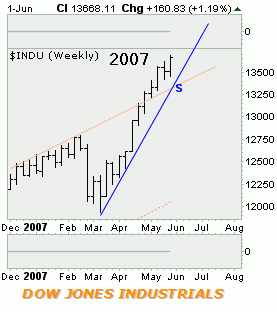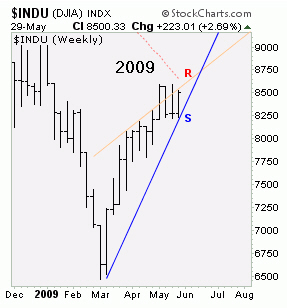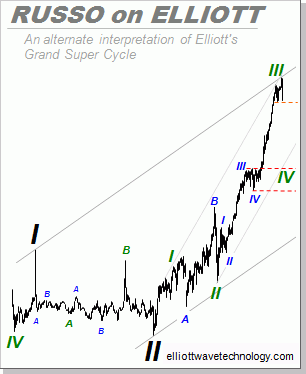Stock Market June Gloom / Summer Rally
Stock-Markets / Stocks Bear Market Jun 03, 2009 - 11:53 PM GMTBy: Joseph_Russo
 Two years ago, and some five months and 1000-pts away from the Dow's historic print high above 14K in October of 2007; we penned an article entitled June Swoon / Summer Rally.
Two years ago, and some five months and 1000-pts away from the Dow's historic print high above 14K in October of 2007; we penned an article entitled June Swoon / Summer Rally.
Following a prescient correction through July of '07, the Dow then went on to print its historic bull market highs in October some three months later.
 Here is what we had to say at the time:
Here is what we had to say at the time:
June 2007- “The Raging Bull we spoke of a couple of weeks ago appears to have taken up permanent residence across many sectors of the financial sphere. This bull has been relentless, cunning, and quite masterful in dealing with the plethora of participants who have been eagerly anticipating some type of correction - if not an outright crash!
After 11-weeks of nothing but blue sky, we suspect this bull may simply be growing bored of the dominance it imposes upon bears at will. Perhaps a couple of weeks respite in June ought to be a minimum at which this easily antagonized bull may once again become angered, electing to resume its deceptive charge with renewed fury."
The top chart shows the Dow's 12-weeks of non-stop rally off the March 2007 low, while the second chart illustrates the somewhat similar 2009 event currently in progress.
We bring this to light in order to illuminate some basic similarities and differences between the rally out of the March low in 2007, and that of present rally occurring from the March low of 2009.
What might some of those similarities and differences be?
 Well, for one, the rally in 2007 from the 12K level translates to roughly a 16% advance, while the current rally of similar duration is racking upwards of 30% movement from its lows. Both rallies span approximately 2000-pts.
Well, for one, the rally in 2007 from the 12K level translates to roughly a 16% advance, while the current rally of similar duration is racking upwards of 30% movement from its lows. Both rallies span approximately 2000-pts.
Secondly, the 2007 rally was a maturing 5th-year continuation of the bullish uptrend established from the previous bear market lows of 2002.
In the top chart, one can see the 2007 market maintaining itself well above its rising 40-week MA dashed in red, which comes into view in a rising posture at the base of the chart in mid-April.
In contrast, the 2009 rally is the first sustained initial reaction to an outright sudden 2-yr CRASH-LOW that rapidly followed the historic highs registered in October of 2007.
In the second chart, one can see that the current 2009 market still trades below, but is fast approaching encounter with its falling 40-week MA dashed in red just above the last price bar in May.
What, if anything, might such analogy provide?
First, it illuminates with striking clarity, that "the market" has no clue how to value itself.
In our view, by its inherent nature and design, it never has, and never will value itself accurately.
Periods of steady growth, general calm, and near certainty, invariably lead to a sudden realization by the majority that they had missed or ignored something of considerable fundamental importance amid their hubris to support ever-rising bullish price levels in perpetuity.
Second, we can anticipate with reasonable probability that this multi month rally will ultimately give way to a commensurate decline. The level of commensuration, be it all or a fraction of the advance, will depend upon the market's ability to endure at least a 40-50% retracement of its journey, and then prove it has the foundation and backing to work its way back up to much higher, highs.
The higher it goes without a reasonably commensurate pullback, the more difficult it will likely become to adequately consolidate and then go on to prove itself worthy of such value and assuredness in future upward trajectory.
In short, THERE IS NO CURRENT UPTREND, until a meaningful pullback yields to higher highs beyond those achieved in the first leg of advance.
As in 2007, July provides such opportunity for a commensurate equity consolidation. Following a successful summer/fall rally thereafter, October of 2009, the two-year anniversary of the all-time high may bring with it an echo of the blind bullishness experienced at that time.
Alternately, a continuance of unchecked, unsustainable steady advances through the July period will become much more worrisome come fall.
We hope that you have enjoyed this update, and have gained some insight into current market conditions.
 Trade the Supercycle IV -Wave
Trade the Supercycle IV -Wave
The express focus of Elliott Wave Technology's Near Term Outlook is to help active traders anticipate price direction and amplitude of broad market indices over the short, intermediate, and long-term.
Communications ‘09: To more effectively convey dynamic trading conditions relevant to our technical publications; we have recently launched complimentary E-briefings for anyone interested in following our work. E-brief dispatches will summarize current market conditions and tactical trading postures across various time horizons and trading strategies. Those interested can obtain free-inclusion from the sign-up block on our homepage.
Trade Better / Invest Smarter...
By Joseph Russo
Chief Editor and Technical Analyst
Elliott Wave Technology
Email Author
Copyright © 2009 Elliott Wave Technology. All Rights Reserved.
Joseph Russo, presently the Publisher and Chief Market analyst for Elliott Wave Technology, has been studying Elliott Wave Theory, and the Technical Analysis of Financial Markets since 1991 and currently maintains active member status in the "Market Technicians Association." Joe continues to expand his body of knowledge through the MTA's accredited CMT program.
Joseph Russo Archive |
© 2005-2022 http://www.MarketOracle.co.uk - The Market Oracle is a FREE Daily Financial Markets Analysis & Forecasting online publication.



